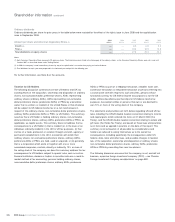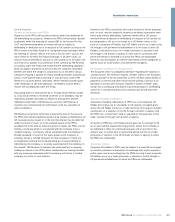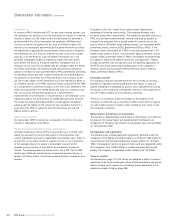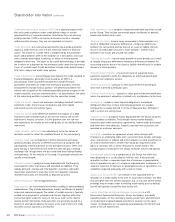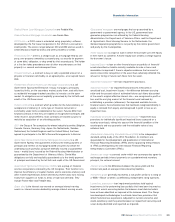RBS 2009 Annual Report Download - page 388
Download and view the complete annual report
Please find page 388 of the 2009 RBS annual report below. You can navigate through the pages in the report by either clicking on the pages listed below, or by using the keyword search tool below to find specific information within the annual report.Shareholder information continued
RBS Group Annual Report and Accounts 2009386
Leveraged loans – funding (leveraged finance) provided to a business
resulting in an overall level of debt that exceeds that which would be
considered usual for the business or for the industry in which it
operates. Leveraged finance is commonly employed to achieve a
specific, often temporary, objective: to make an acquisition, to effect a
buy-out or to repurchase shares.
Liquidity enhancements make funds available to ensure that the issuer
of securities, usually a commercial paper conduit, can redeem the
securities at maturity. They typically take the form of a committed facility
from a third-party bank.
Loan impairment provisions – are established to recognise incurred
impairment losses on a portfolio of loans classified as loans and
receivables and carried at amortised cost. It has three components:
individually assessed loan impairment provisions, collectively assessed
loan impairment provisions and latent loss provisions.
Loan-to-value ratio – the amount of a secured loan as a percentage of
the appraised value of the security e.g. the outstanding amount of a
mortgage loan as a percentage of the property’s value.
Loss given default (LGD) – the economic loss that may occur in the
event of default i.e. the actual loss – that part of the exposure that is not
expected to be recovered – plus any costs of recovery.
Master netting agreement is an agreement between two counterparties
that have multiple derivative contracts with each other that provides for
the net settlement of all contracts through a single payment, in a single
currency, in the event of default on, or termination of, any one contract.
Medium term notes (MTNs) are debt securities usually with a maturity of
five to ten years, but the term may be less than one year or as long as
50 years. They can be issued on a fixed or floating coupon basis or with
an exotic coupon; with a fixed maturity date (non-callable) or with
embedded call or put options or early repayment triggers. MTNs are
most generally issued as senior, unsecured debt.
Monoline insurers are entities that specialise in providing credit
protection against the notional and interest cash flows due to the
holders of debt instruments in the event of default. This protection is
typically in the form of derivatives such as credit default swaps.
Mortgage-backed securities – are asset-backed securities for which the
underlying asset portfolios are loans secured on property. See
residential mortgage backed securities and commercial mortgage
backed securities.
Mortgage servicing rights are the rights of a mortgage servicer to
collect mortgage payments and forward them, after deducting a fee, to
the mortgage lender.
Mortgage vintage – the year in which a mortgage loan was made to the
customer.
Negative equity mortgages – mortgages where the value of the property
mortgaged is less than the outstanding balance on the loan.
Net interest income is the difference between interest receivable on
financial assets classified as loans and receivables or available-for-sale
and interest payable on financial liabilities carried at amortised cost.
Net interest margin is net interest income as a percentage of average
interest-earning assets.
Net principal exposure is the carrying value of a financial asset after
taking account of credit protection purchased but excluding the effect
of any counterparty credit valuation adjustment to that protection.
Non-accrual loans comprise all loans for which an impairment provision
has been established; for collectively assessed loans, impairment loss
provisions are not allocated to individual loans and the entire portfolio is
included in non-accrual loans.
Non-conforming mortgages – mortgage loans that do not meet the
requirements for sale to US Government agencies or US Government
sponsored enterprises. These requirements include limits on loan-to-
value ratios, loan terms, loan amounts, borrower creditworthiness and
other requirements.
Option - an option is a contract that gives the holder the right but not the
obligation to buy (or sell) a specified amount of the underlying physical
or financial commodity, at a specific price, at an agreed date or over an
agreed period. Options can be exchange-traded or traded over-the-
counter.
Past due – a financial asset such as a loan is past due when the
counterparty has failed to make a payment when contractually due.
Potential problem loans – are loans other than non-accrual loans,
accruing loans which are contractually overdue 90 days or more as to
principal or interest and troubled debt restructurings where known
information about possible credit problems of the borrower causes
management to have serious doubts about the borrower’s ability to meet
the loan’s repayment terms.
Prime - prime mortgage loans generally have low default risk and are
made to borrowers with good credit records and a monthly income that
is at least three to four times greater than their monthly housing expense
(mortgage payments plus taxes and other debt payments). These
borrowers provide full documentation and generally have reliable
payment histories.
Private equity investments are equity investments in operating
companies not quoted on a public exchange. Capital for private equity
investment is raised from retail or institutional investors and used to fund
investment strategies such as leveraged buyouts, venture capital,
growth capital, distressed investments and mezzanine capital.
Pro forma cost:income ratio – operating expenses excluding purchased
intangibles amortisation, write-down of goodwill and other intangible
assets, integration and restructuring costs and share of shared assets
expressed as a percentage of total income excluding credit market
write-downs and one-off items.
Probability of default (PD) – the likelihood that a customer will fail to
make full and timely repayment of credit obligations over a one year
time horizon.
Regular way purchase or sale is a purchase or sale of a financial asset
under a contract whose terms require delivery of the asset within the
time frame established generally by regulation or convention in the
marketplace concerned.




